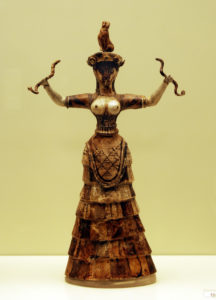The iconic statuettes from Bronze Age Crete are of women (priestesses probably although some scholars claim they are the Goddess) with snakes twining up their arms and around their waists. Snakes were sacred in this Bronze Age religion.

Snake Goddess describes a number of figurines of a woman holding a serpent in each hand found during excavation of Minoan archaeological sites in Crete dating from approximately 1600 BCE. By implication, the term ‘goddess’ also describes the deity depicted; although little more is known about her identity apart from that gained from the figurines. The ‘Snake Goddess’ figure first discovered was found by the British archaeologist Arthur Evans in 1903. The figurine found by Arthur Evans uses the faience technique, for glazing earthenware and other ceramic vessels by using a quartz paste. After firing this produces bright colors and a lustrous sheen. The figurine is today exibited at the Herakleion Archeological Museum in Crete. The snake’s close connection with the Minoan house is believed to indicate that the goddesses shown in these figures are Household Goddesses.
http://en.wikipedia.org/wiki/Snake_Goddess
The shedding of their skins was a symbol of rebirth and regeneration. One of the resources I read said that the snakes were allowed to live in the houses. (I am not sure how she knows that.) If so, I’m sure that the presence of the snakes kept down the mice.
Currently Crete does not have native venomous snakes and it is thought that there no venomous snakes in Crete during the Bronze either. So, of course I had to wonder if the asp was ever imported from Egypt.
(I think everyone knows that Cleopatra is supposed to have committed suicide with an asp. According to my research, however, it was a mixture of poisons including opium and wolfsbane. But I digress.)
The asp’s bite is very venomous. The victim dies in about four minutes.
